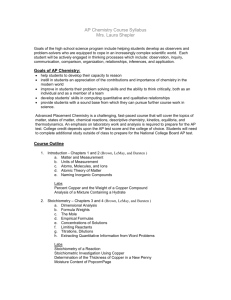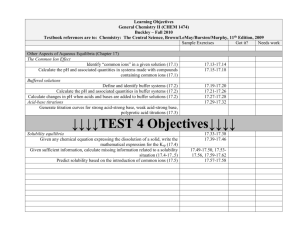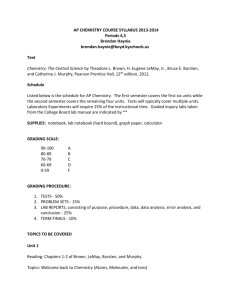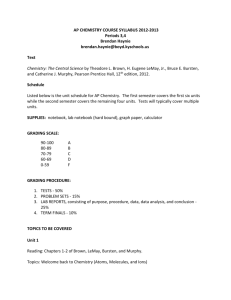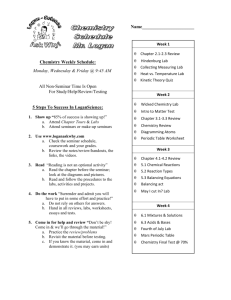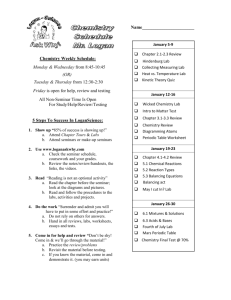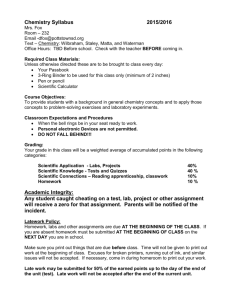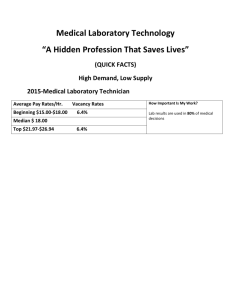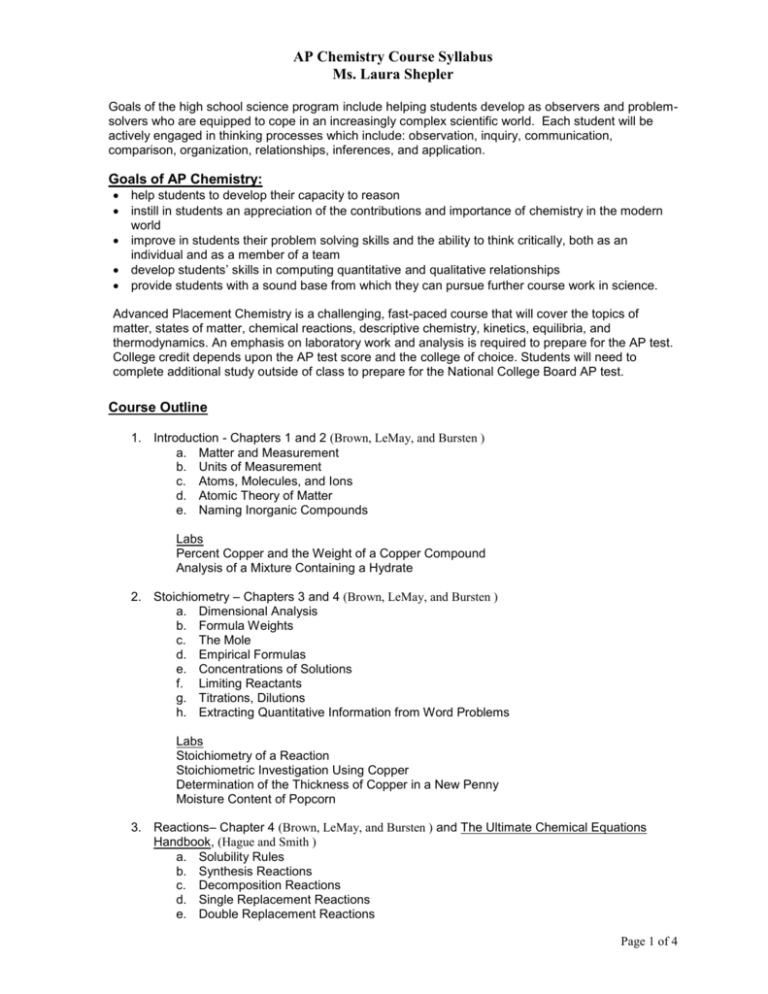
AP Chemistry Course Syllabus
Ms. Laura Shepler
Goals of the high school science program include helping students develop as observers and problemsolvers who are equipped to cope in an increasingly complex scientific world. Each student will be
actively engaged in thinking processes which include: observation, inquiry, communication,
comparison, organization, relationships, inferences, and application.
Goals of AP Chemistry:
help students to develop their capacity to reason
instill in students an appreciation of the contributions and importance of chemistry in the modern
world
improve in students their problem solving skills and the ability to think critically, both as an
individual and as a member of a team
develop students’ skills in computing quantitative and qualitative relationships
provide students with a sound base from which they can pursue further course work in science.
Advanced Placement Chemistry is a challenging, fast-paced course that will cover the topics of
matter, states of matter, chemical reactions, descriptive chemistry, kinetics, equilibria, and
thermodynamics. An emphasis on laboratory work and analysis is required to prepare for the AP test.
College credit depends upon the AP test score and the college of choice. Students will need to
complete additional study outside of class to prepare for the National College Board AP test.
Course Outline
1. Introduction - Chapters 1 and 2 (Brown, LeMay, and Bursten )
a. Matter and Measurement
b. Units of Measurement
c. Atoms, Molecules, and Ions
d. Atomic Theory of Matter
e. Naming Inorganic Compounds
Labs
Percent Copper and the Weight of a Copper Compound
Analysis of a Mixture Containing a Hydrate
2. Stoichiometry – Chapters 3 and 4 (Brown, LeMay, and Bursten )
a. Dimensional Analysis
b. Formula Weights
c. The Mole
d. Empirical Formulas
e. Concentrations of Solutions
f. Limiting Reactants
g. Titrations, Dilutions
h. Extracting Quantitative Information from Word Problems
Labs
Stoichiometry of a Reaction
Stoichiometric Investigation Using Copper
Determination of the Thickness of Copper in a New Penny
Moisture Content of Popcorn
3. Reactions– Chapter 4 (Brown, LeMay, and Bursten ) and The Ultimate Chemical Equations
Handbook, (Hague and Smith )
a. Solubility Rules
b. Synthesis Reactions
c. Decomposition Reactions
d. Single Replacement Reactions
e. Double Replacement Reactions
Page 1 of 4
AP Chemistry Course Syllabus
Ms. Laura Shepler
f. Ionic Equations
g. Net Ionic Equations
Labs
Oxidizing Power of Laundry Bleach
Standardization of a Base – Analysis of Vinegar
4. Thermodynamics – Chapters 5 and 19 (Brown, LeMay, and Bursten )
a. Laws of Thermodynamics
b. Calorimetry
c. Hess’s Law
d. Enthalpy
e. Entropy
f. Gibbs Free Energy
Labs
Heats of Reaction and Hess’s Law
Entropy of Reaction
5. Structure and Periodicity of Atoms – Chapters 6 and 7 (Brown, LeMay, and Bursten )
a. Quantum Mechanics and Orbitals
b. Orbitals and Energies
c. Electron Configurations
d. Effective Nuclear Charge
e. Atomic Radii
f. Ionization Energy
g. Electron Affinity
h. Group Trends
Labs
Hydrogen Spectra
6. Chemical Bonding – Chapters 8 and 9 (Brown, LeMay, and Bursten )
a. Lewis Structures and the Octet Rule
b. Ionic vs. Covalent Bonding
c. Polarity and Electronegativity
d. Resonance Structures
e. Molecular Geometries
f. Hybridization
g. Multiple Bonds
7. Gases – Chapter 10 (Brown, LeMay, and Bursten )
a. Pressure
b. Kinetic-Molecular Theory
c. The Gas Laws
d. The Ideal Gas Equation and Deviations
e. Molar Mass and Density
f. Partial Pressure
g. Effusion and Diffusion
Labs
Molar Mass of Carbon Dioxide
Molar Volume of a Gas
8. Phases of Matter, Solutions, and Their Properties – Chapters 11 and 12 (Brown, LeMay, and
Bursten )
a. Intermolecular Forces
b. Viscosity and Surface Tension
Page 2 of 4
AP Chemistry Course Syllabus
Ms. Laura Shepler
c.
d.
e.
f.
g.
h.
i.
Vapor Pressure
Changes of State and Phase Diagrams
Structures of Solids
Bonding in Solids
The Solution Process
Solubility
Colligative Properties
Labs
Molecular Weight by Freezing Point Depression
9. Kinetics and Equilibrium – Chapters 14 and 15 (Brown, LeMay, and Bursten )
a. Reaction Rates and Influences Upon Them
b. Reaction Mechanisms
c. Catalysis
d. Equilibrium Constants
e. Le Chatelier’s Principle
Labs
Iodination of Acetone
Kinetic Study of KI with K2S2O8
Spectrophotometric Determination of an Equilibrium Constant
Determining of the Ksp for Silver Acetate using Le Chatelier’s Principle
Ksp of Copper (II) Tartrate
10. Acid-Base Equilibria – Chapters16 and 17 (Brown, LeMay, and Bursten )
a. Bronsted-Lowry Acids and Bases
b. pH
c. Strong/Weak vs. Concentrated/Dilute
d. Acid and Base Dissociation Constants
e. Lewis Acids and Bases
f. Titrations
g. Buffers
h. Solubility Equilibria
Labs
pH Titration Curves and Acid Base Indicators
Buffer Preparation and Buffer Capacity
Calibration of a buret
Acid Content of Fruit Juices
Determination of the Ka of a Weak Acid
Titration of Polyprotic Acids
11. Electrochemistry – Chapter 20 (Brown, LeMay, and Bursten )
a. Redox Reactions
b. Voltaic Cells
c. Cell EMF
d. Electrolysis
e. Corrosion
Labs
The Activity Series of Metals
Electrochemistry: Voltaic Cells
Electrolytic Cells
12. Nuclear Chemistry – Chapter 21 (Brown, LeMay, and Bursten )
a. Radioactivity
b. Nuclear Stability Patterns
Page 3 of 4
AP Chemistry Course Syllabus
Ms. Laura Shepler
c.
d.
e.
f.
g.
h.
Transmutations
Decay
Detection
Fission
Fusion
Biological Effects
Labs
Half-Life of Barium-137
13. Organic Chemistry – Chapter 25 (Brown, LeMay, and Bursten )
a. General Characteristics
b. Nomenclature/Functional Groups
c. Combustion Reactions
d. Addition Reactions
e. Isomers
f. Aromatic Hydrocarbons
g. Chirality
Labs
Spectrophotometric Analysis of Aspirin
Thin Layer Chromatography of Analgesics
Analysis of Mouthwash
Preparation and Analysis of Alum
Qualitative Identification of Solutions
Resources
Anderson, Guy. "Advanced Placement Chemistry Labs." Juniata College Science In Motion. 2000. Juniata
College. 8 Nov 2006 <http://services.juniata.edu/ScienceInMotion/chem/ap-2.html>.
Brown, Theodore L., H. Eugene LeMay, Jr., and Bruce E. Bursten. Chemistry: The Central Science. 10th. Upper
Saddle River, NJ: Pearson: Prentice Hall, 2006.
Hague, Jr., George R., and Jane D. Smith. The Ultimate Chemical Equations Handbook. 1st. Batavia, IL: Flinn
Scientific, Inc., 2001.
Vonderbrink, Sally Ann. Laboratory Experiments for Advanced Placement Chemistry. 1st. Batavia, IL: Flinn
Scientific, Inc., 1995.
Assessments
Students’ work is evaluated based on their performance on homework, quizzes, tests, written
lab reports, and first and second semester finals. Grading is done by dividing the student’s
point total by the total possible points. There is no curving of grades or extra credit.
There were be problem sets from the textbook for each unit along with teacher-created
practice worksheets. After the completion of Unit 3, Reactions, there will be weekly reaction
quizzes (usually on Fridays). There will be a unit test at the completion of each unit. Unit
tests will be written to follow the format of the College Board AP Exam, with a free response
section allowing calculators and a multiple choice section where calculators are prohibited.
Lab notebooks will be kept by each student with reports written within those lab notebooks at
the completion of each laboratory.
Page 4 of 4

